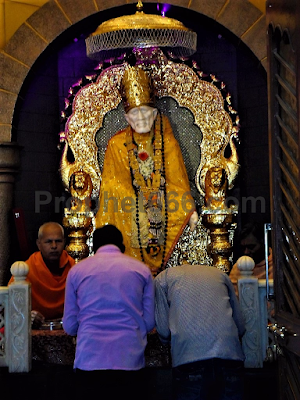Taking Parikrama or Pradakshina in a temple is a most common religious ritual in India. It means, walking in the Dakshin or right direction [along with the flow of energy] and circling the Inner Sanctum where the Murti of the Presiding God or Goddess of the temple is installed.
The most powerful vibrations, which are circulating in the temple are at their strongest around the area near the Idol of the Presiding Deity of the temple. For example if you are in a Ganapati Mandir, the vibrations will be at their strongest around the Inner Sanctum or Garbhagriha, in which the Ganesh Murti has been installed.
Most of the times, there are idols of other deities installed around the idol of the Presiding Deity of the temple, the energy flow from these idols also gravitates towards the main idol of the temple.
The real reason behind taking Parikrama is to soak-in the most helpful and beneficial energy circulating in the temple and to remove and be free from negative energies that are affecting the body.. The reason behind taking the Dakshin or Clockwise Path is to go with the flow of the Divine Energy present in the temple.
Advanced Spiritualists and Siddha Sadhaks are able to see, feel and experience the invisible Divine Vibrations that are revolving in a temple.
The practice of Parikrama is also present in other religions, including Islam, Buddhism and Christianity. The names and traditions given might differ from religion to religion, but the real reasoning behind this age-old practice is the same, which is to benefit from the helpful vibration present in the shrine.
Many a times there is no Parikrama Path present is some temples, the could be mainly due to the shortage of space or wrong architecture. Having no Parikrama Path is wrong, but in such cases, the devotees can rotate around themselves, in a clockwise manner, so as to reap the full benefits of preforming Parikrama.
The real reason and importance behind the chanting of Mantras, Stotras and Chalisas of a deity, in a temple dedicated to that deity is the same, the fruits from the reciting of these prayers is gained quickly.
The most powerful vibrations, which are circulating in the temple are at their strongest around the area near the Idol of the Presiding Deity of the temple. For example if you are in a Ganapati Mandir, the vibrations will be at their strongest around the Inner Sanctum or Garbhagriha, in which the Ganesh Murti has been installed.
Most of the times, there are idols of other deities installed around the idol of the Presiding Deity of the temple, the energy flow from these idols also gravitates towards the main idol of the temple.
The real reason behind taking Parikrama is to soak-in the most helpful and beneficial energy circulating in the temple and to remove and be free from negative energies that are affecting the body.. The reason behind taking the Dakshin or Clockwise Path is to go with the flow of the Divine Energy present in the temple.
Advanced Spiritualists and Siddha Sadhaks are able to see, feel and experience the invisible Divine Vibrations that are revolving in a temple.
The practice of Parikrama is also present in other religions, including Islam, Buddhism and Christianity. The names and traditions given might differ from religion to religion, but the real reasoning behind this age-old practice is the same, which is to benefit from the helpful vibration present in the shrine.
Many a times there is no Parikrama Path present is some temples, the could be mainly due to the shortage of space or wrong architecture. Having no Parikrama Path is wrong, but in such cases, the devotees can rotate around themselves, in a clockwise manner, so as to reap the full benefits of preforming Parikrama.
The real reason and importance behind the chanting of Mantras, Stotras and Chalisas of a deity, in a temple dedicated to that deity is the same, the fruits from the reciting of these prayers is gained quickly.

कहते हैं भगवान के पूजन और आरती के बाद उसी स्थान पर तीन परिक्रमा अवश्य करनी चाहिए .
ReplyDeleteकहते हैं कि भगवान विष्णु की 4,गणेश की 3,सूर्यदेव की 7,दुर्गा की 1,तथा शिव की आधी परिक्रमा कर सकते हैं .